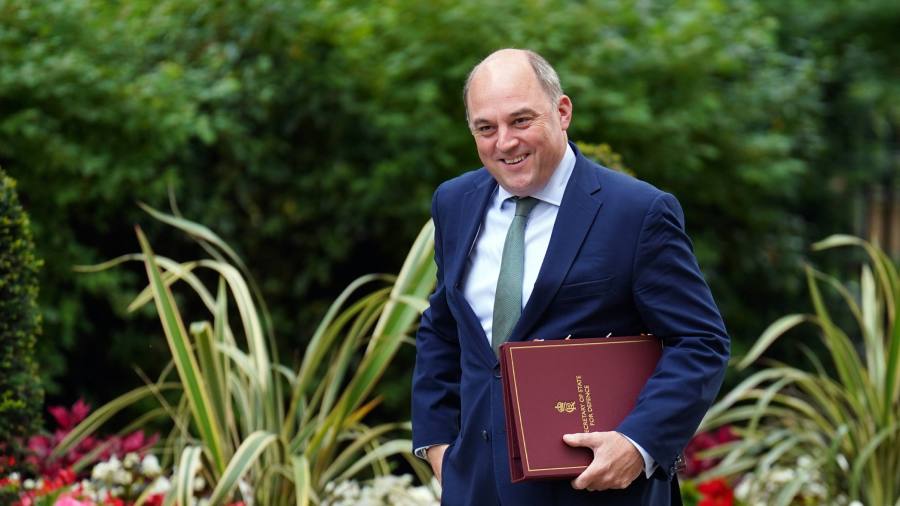Receive free UK defence updates
We’ll send you a myFT Daily Digest email rounding up the latest UK defence news every morning.
Britain’s armed forces will adopt a “campaigning mindset” as part of a new science-driven strategy that could soon see robot tanks on the battlefield firing laser weapons guided by off-the-shelf drones with the help of artificial intelligence.
Such futuristic armaments, which combine high-tech with low-cost, are some of the more novel possibilities for the UK’s approach to war-fighting, according to the defence command paper unveiled by outgoing defence secretary Ben Wallace in parliament on Tuesday.
“We must shift our whole organisational culture away from the previous peacetime mentality to one where we live and operate as we would fight,” Wallace told MPs. “We are now investing significantly more to stay ahead [in] technologies [that are] proving themselves vital on the battlefields of Ukraine, such as AI, quantum and robotics.”
Opposition politicians and military analysts said the strategy failed to rise to the challenge of Europe’s biggest land conflict since the second world war, even though it was informed by military lessons gleaned from Russia’s war in Ukraine.
Shadow defence secretary John Healey said it was “clear” that the plan was “driven by costs, not by threat”, adding: “Where is the halt to further cuts in the army . . . Where is the commitment to fulfil, in full, our Nato obligations?”
Paul O’Neill, director of military sciences at the Royal United Services Institute think-tank, said that because the Treasury had not given the military new funding, “there are no new armaments”. He added that the strategy “doesn’t deliver a genuine response to the war in Ukraine, and essentially kicks the can down the road” until the next spending review in 2024 or 2025.
The 97-page document is the military contribution to Downing Street’s revamped integrated review of defence, security and foreign policy. Published earlier this year, the review set out Britain’s plans to counter Russia and the “epoch-defining challenge” posed by China.
At the strategy’s core lies a focus on science and new technologies that scour the battlefield for information, provide precise targeting data, intercept and jam adversaries’ communications, and help frontline soldiers and headquartered commanders make better decisions.
The paper also stressed the need for agility and adaptability as a source of battlefield advantage. It said this could sometimes be achieved through low-tech approaches such as Ukrainian roofing materials, which were cited enigmatically as a “£100 solution . . . that can be combined to achieve unique battle-winning effects against Russian capabilities that have cost hundred of millions of pounds”.
But the strategy also tacitly recognised that its focus on technology and improved productivity was driven by a lack of fresh funding and the need to make budgets go further.
Despite an annual defence budget of £50bn, the second highest in Nato after the US, the UK is set to shrink its army to 73,000 troops by 2025 — the lowest number since the 1800s. The number of main battle tanks will also fall from more than 200 to just 148 Challenger 3s.
UK prime minister Rishi Sunak has pledged to raise defence spending to 2.5 per cent of gross domestic product from 2 per cent now, but only as economic conditions allow.
“Defence must deliver more, at an accelerating pace. As budgets are finite, this can only be achieved by aggressively driving productivity,” the paper said.
Wallace on Tuesday reiterated his defence of the cut in troop numbers, telling MPs: “We can argue about size, but what we have to make sure is that whatever we put in the field is properly enabled.
“There is no point in pretending we can have a huge number without a defence budget to support that,” he added.
As part of the command paper, £2.5bn will be reallocated from within the Ministry of Defence budget to rebuild the UK’s stores of ammunition, much of which has been sent to Ukraine. Another £400mn will go towards improving accommodation for British troops.
Defence analysts said that although the strategy would eventually lead to a more integrated and potent force, as £242bn of equipment upgrades budgeted for the next decade come through, the time-lag put British security at risk of falling behind rivals.
In the meantime, other land forces closer to Russia, such as Poland and Finland, are investing heavily in tanks and artillery. The UK also brings other capabilities to its Nato allies, such as its nuclear deterrent, navy and air force.
Even so, General Sir Richard Barrons, former head of the armed forces, called it “a gamble and not a well-calculated risk”.
“There is a huge gap between some excellent thinking and policy, and the means and funding to deliver it soon,” he said. “Essentially, we are asking our allies to bear with us. But mostly we need our enemies to leave us alone until at least 2030.”
Read the full article here



